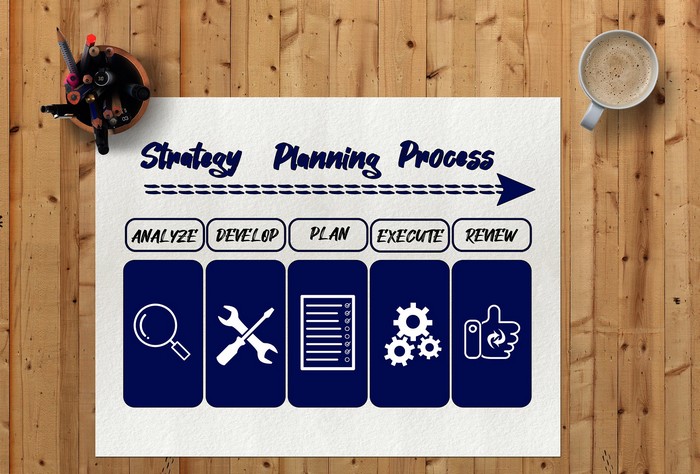Business strategies can make or break a business. It defines whether a business or brand will be successful or not. Through the right business strategies, even start-ups can outrank the competition fast.
If you want your business to stay competitive in your niche or target market, you must have a vision tied to sound business strategies.
Amazon is an excellent example of well-executed business strategies tied to their vision as a company. This top eCommerce business is the most customer-focused company worldwide.
Amazon provides a seamless experience with their products and services so their customers can come to a place, find, discover and buy online.
Amazon launched Amazon Go in 2016, a touchless technology that significantly transforms consumers’ shopping experience. It is a connected grocery store that promises no lines, no check-outs, and no registers. It uses what Amazon calls a “Just Walk Out” technology that combines deep learning algorithms, computer vision, and sensor fusion, just like auto-driving technology.
Just walk into an Amazon Go store, check-in on their phones through the Amazon Go app, and shop. They can check it out automatically by taking items off the shelf. Then the multiple sensors record the items. Finally, through the Amazon app, the customer is charged with their selected store items on their account.
What an amazing display of how customers come in first for Amazon. It is a clear example for businesses big and small alike, how the right business strategies can bring remarkable success to a business or brand.
Tips for Effective Business Strategies
Building a strategy can help you achieve both your short-term and long-term goals. Your business strategy will give you focus on why your business does certain ventures and activities, not just how you do them or what you do. Here are some of the ways you can create and execute your business’ very own business strategy.
1. Data Gathering

You can’t simply immerse yourself in strategies without knowing where your company is now, what got you here and what you plan to do in the future.
It is crucial to know what strategies have worked and failed in your business journey. You need to review your business’ performance and key metrics, and investments made, including gains and losses. Analyze every business area and identify what worked well, what could have been better and what prospects are ahead.
You can use tools such as SWOT analysis, which identifies the Strength, Weakness, Opportunities, and Threats that your business displayed or encountered in the past year, at least.
An excellent framework for assessing external factors, especially for more prominent companies, is PESTLE, or Political, Economic, Social, Technological, Legal and Environmental. So, for your business strategies, determine what opportunities and threats has or could continue to arise under each category.
2. Define Your Goals
The goal at this point is to establish a range of high-level targets for your business. It would help if you outlined business goals and draft plans for executing the business’s vision and mission.
After you have done a SWOT or PESTLE analysis, you can now highlight your objectives through SMART Goals (Specific, Measurable, Achievable, Realistic, Time-Bound).
- Specific: Your goal should be specific and precise. Answer questions such as, “What do I want to achieve?” “Why is it important?” “Who are the people involved?” “Where is my business location?” “What resources will my business need?” “And, what problems might I encounter?”
- Measurable: Your goal needs to be measurable. It will help you evaluate your progress and remain focused and motivated by setting specific goals and deadlines.
- Achievable: Your goal should not be out of reach, but at the same time, should be able to stretch your abilities. You need achievable and realistic goals to keep the business focused and continually moving forward. You and the team would be frustrated to set ambitious targets, which cannot be accomplished realistically.
- Relevant: Examine if your business goal is relevant or applicable. Ensure that your business objectives are meaningful and it parallels your goals for this time.
- Time-bound: Your target needs to be time-bound. If you have a deadline in place, it would be easier to concentrate on completing your goal and keep you away from other, less important activities.
Anyone can easily use SMART goals without specialized tools or training. It offers clarity and inspiration to achieve your objectives successfully.
3. Define Market Segments to Capture

You need to determine where your business best fits in the market so you can harness your efforts and resources correctly.
Customers who need and want your product or service are often the customers who are the most likely to convert. Customer retention is more feasible for these types of customers. In effect, it raises the lifetime value of your customer and reduces customer-acquisition investments.
So don’t let your business be a product of poor targeting. You need to have distinct targets, so your message is aligned between sales and marketing.
If you haven’t done so by now, clearly identify the niches and specialties where your business lies. You do not want to be too niche either. You need to retain some relevance on your target market’s broader segment.
It gives your business the ability to create an integrated sales and marketing strategy when target markets are clearly defined. Your digital marketing efforts will enable sales productivity.
4. Develop Your Online Presence
Having a professional-looking website is an essential advantage for any business. Your website is where you can show who you are, what you’re selling, where you’re based, and how prospective clients can contact you.
You will show the history of your business and other fascinating stories about your brand. People follow the brands or blogs and the stories behind the brand and the people related to those stories.
A website is a channel that can produce organic traffic and is an avenue to send traffic from ads and other digital marketing strategies. It acts like a 24/7 salesperson and boosts your online presence as a brand.
Conclusion: The New Normal Demands Innovation
These are just some of the ways you can create sound business strategies for the new normal economy. Business strategies are so crucial nowadays. It bases your business on standards applicable in almost any situation, which in turn helps your company achieve its short- and long-term objectives.
But beyond that, also be a business that continually innovates. The global pandemic pushed businesses to innovate if they wanted to survive the market amid strict social distancing restrictions. Most businesses had to go online or remote and worked in distributed teams and operations. But it was necessary because the situation calls for it.
A business with clear business strategies will more likely make the right decisions faced with a calamity or crisis than businesses that are less focused and targeted.
Mayleen Meñez used to work in media before finding her true passion in NGO work, traveling the Philippines and Asia doing so. She homeschools 3 kids and loves reinventing Filipino dishes. She is a resident SEO writer for Softvire Australia and Softvire New Zealand.






